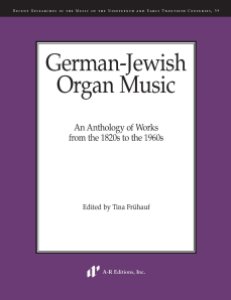German-Jewish organ music: An anthology of works from the 1820s to the 1960s, edited by Tina Frühauf (Madison: A-R Editions, 2013), traces the main phases of the history and stylistic development of organ music in the Reform Jewish communities in Central Europe, as well as in the German-influenced communities of Königsberg (Kaliningrad) and Odessa, and works by German-Jewish composers who emigrated to the U.S. and Israel after World War II.
The small but respectable body of compositions for the organ in the synagogue is represented by fourteen exemplary works; the pieces span the period beginning with the Reform movement in the early 19th century to post-Holocaust works in the mid-20th century.
Initially oriented predominantly toward Christian models, a specifically Jewish style of organ music emerged in the late 19th century, made up from elements of both Jewish and Western musical cultures. The selected repertoire featured in the anthology, although all emanating from the same cultural milieu, is based on a wide variety of musical thematic material, including biblical cantillation, 19th-century synagogue song, Yiddish folk song, and the musical traditions of various Jewish cultural groups (Ashkenazic, Sephardic, and Yemenite).
Some of the selected repertoire corresponds to detailed analyses published in the editor’s monograph The organ and its music in German-Jewish culture (New York: Oxford University Press, 2009).
Below, music by Louis Lewandowski, with an assortment of relevant images; he is represented in German-Jewish organ music by his Fünf Fest-Präludien (1871),
Related article: American cantorate




